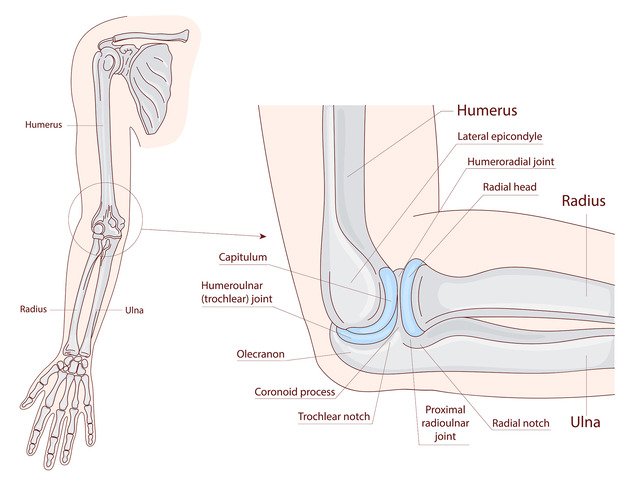About elbow osteoarthritis
What is osteoarthritis
Osteoarthritis (OA) is a condition that causes joints to become painful and stiff. It’s the most common type of arthritis (NHS) in the UK. Over time the surface of the joint changes and the surrounding bone grows thicker. This can cause a reduction in the range of movement of the elbow.

Risk factors
Age: Your risk of developing the condition increases as you get older. The majority of people with OA are over the age of 45.
Family history: Osteoarthritis may run in families, although studies have not identified a single gene responsible, genes can affect how well tissues repair.
Women are more likely than men to be affected.
Symptoms of osteoarthritis
The severity of osteoarthritis symptoms can vary greatly from person to person, and between different affected joints. There may be good days and bad days, or even good and bad months, for no apparent reason
The main symptoms of osteoarthritis are joint pain and stiffness and problems moving the joint, other symptoms include, swelling, tenderness, audible sounds (grating or crackling), sound when moving or discoloration.
Changes in the weather may make a difference in some people. All joints have nerve endings which are sensitive to pressure. The nerve endings may respond to the drop in atmospheric pressure which occurs before it rains.
What should I do if I have elbow pain: How can I tell if it is arthritis?
It is important to see a GP, nurse or physiotherapist if you have elbow pain that persists for more than 4 weeks. They will be able to give you an accurate diagnosis either by examining you or listening to you talk about your symptoms.
Physiotherapists are experts in joints and in movement. They are also experts in exercise prescription. They can give you the knowledge to help you manage your condition.
What can I do to help myself?
Because arthritis of the elbow is a long term condition that does not go away, it is important to know what you can do to manage the condition yourself.
When your movement is affected by pain you can:
- Use heat or ice over the painful area (most people have a preference for one or the other).
- Take painkillers: A lot of people with osteoarthritis will need painkillers at some time. For most people over the counter medications such as paracetamol and or ibuprofen including anti-inflammatory gels or creams can help. If you are unsure about taking these speak to your pharmacist or GP. Some people may need a stronger painkiller which they can get short term from their pharmacist or if they need painkillers longer term their GP can help with this.
- Symptom management and control: Avoid the boom and bust cycle. A common mistake that people make is over doing things, doing too much in one go. They then find their pain gets worse.
- Graded exposure to activity or exercise: specifically painful activity or in relation to specific exercise programme. Exercising gradually and build up over time, and remember to carry on even when your elbow is better to prevent your symptoms returning.
What can I do if I can’t help myself?
All of the evidence suggests, that those with osteoarthritis who exercise regularly have less pain and better function that those who don’t exercise. However, if you are still struggling after trying all of these, it may be appropriate to try other more invasive treatments.
Corticosteroid injections can help with pain. By easing the pain it can make it more comfortable to perform your physiotherapy exercises. Generally the effects of the injection will wear off after six weeks. So this is an extra treatment rather than an alternative to exercise.
Occasionally when movement is more severely restricted it can be appropriate to try surgery.
Patient information: Elbow osteoarthritis exercises
Level 1 exercises
Level 1 exercises
Assisted elbow flexion

- Sit straight with the point of your elbow on the armchair or table
- Bend the elbow until a stretch is felt
- Push slightly with the opposite hand to increase the stretch. Maintain the position and relax
Assisted elbow extension

- Sit straight with the point of your elbow on the armchair or table
- Straighten your elbow until a stretch is felt
- Push slightly with the opposite hand to increase the stretch. Maintain the position and relax
© Image credit: Wibbi
Level 2 exercises
Level 2 exercises
Isometric elbow flexion

- Sit on a chair with your elbow bent and turn the palm of your hand facing upward
- Grab your wrist with the other hand and try to bend your elbow as hard as you
can, resisting the movement with the other hand - Relax and repeat
Isometric elbow extension

- Place your hand under your wrist (affected side)
- Attempt to straighten your elbow but resist any actual movement with your other hand
- Hold for the recommended duration
© Image credit: Wibbi
Level 3 exercises
Level 3 exercises
Biceps curl

- Seated in a chair with a weight in your hand
- Elbow glued to the side of your body
- Lift the weight up to the ceiling while keeping elbow still
- Return and repeat
© Image credit: Wibbi


